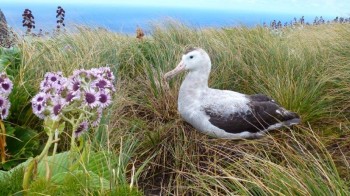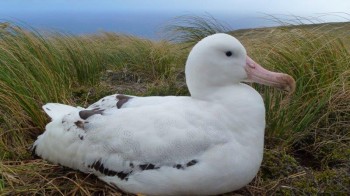Adams Island (101 km²) forms part of New Zealand’s Auckland Islands National Nature Reserve. It lies at the southern end of the main Auckland Island separated by a narrow channel, known as Carnley Harbour. Adams Island is mountainous with high coastal cliffs in places, rising to 705 m at Mount Dick.
The island’s coastal vegetation includes Southern Rātā Metrosideros umbellata forest and the inland mire and moorland habitats contain several species of megaherbs which make a colourful display when flowering, notably in an area known as Fairchild’s Garden in the north-west of the island.

Adams Island across from Carnley Harbour taken from South West Cape on Auckland Island. Photograph by Barry Baker

Some of the tallest sea cliffs in the World can be found on the southern coast of Adams Island. The cliffs visible here at the mouth of Astrolabe Basin reach about 300 m while those in the far distance on the lee of Mt Dick are c. 500 m high. Photograph by Colin O'Donnell

Mount Dick is the highest point on the left. The low-altitude band of Southern Rātā/Dracophyllum forest along Carnley Harbour rises to a maximum of 200 m merging into Chionochloa tussock grasslands on mid-altitude slopes then to rocky fellfield on the tops. Photograph by Colin O'Donnell

Lake Turbot on Adams Island, photographed by Erica Sommer
The island group is surrounded by a recently declared large marine reserve: the Auckland Islands/Motu Maha Marine Reserve that covers an area of c. 484 000 ha (click here).
Adams Island falls within the New Zealand Sub-Antarctic Islands World Heritage Site inscribed in 1998 which includes five island groups (Antipodes Islands, Auckland Islands, Bounty Islands, Campbell Island and the Snares Islands). The island is part of the proposed Auckland Islands Important Bird Area (IBA).
Six species of ACAP-listed albatrosses and petrels breed on Adams Island. Population sizes in annually breeding pairs for five of them are taken from the ACAP Data Portal:
Antipodean (Gibson’s) Albatross Diomedea antipodensis gibsoni: 3227 (2009)
Southern Royal Albatross Diomedea epomophora: 15 (1991)
Light-mantled Sooty Albatross Phoebetria palpebrata: 5000* (1973)
White-capped Albatross Thalassarche steadi: 183 (2013)
Northern Giant Petrel Macronectes halli: 35 (2004).
*island group estimate with most occurring on Adams Island.
A recent report to the New Zealand Department of Conservation has estimated the Adams’ Antipodean Albatross breeding population in 2013 as 4998 pairs. Long-term research on this globally Vulnerable species on Adams Island has shown declines in adult survival, productivity and recruitment; it is regarded as "Nationally Critical” in New Zealand (click here).

Female Antipodean Albatross on its nest in tussock, the megaherb Campbell Island Daisy Pleurophyllum speciosum is in the foreground

An unusually white male Antipodean Albatross – probably denoting great age
Photograph by Colin O'Donnell
Several hundred pairs of Light-mantled Sooty Albatrosses breed on Adams’ southern cliffs but their numbers are thought have decreased over the last 15 years.

A pair of Light-mantled Sooty Albatrosses on Adams Island among megaherbs
Photograph by Colin O'Donnell
Information on trends of White-capped Albatrosses in the Auckland Islands based on aerial counts suggests a stable population (click here)
In addition to the above ACAP-listed species, the White-chinned Petrel Procellaria aequinoctialis breeds on Adams Island.
The island has no (and has never had any) introduced mammals and tourism is not allowed. Small research parties that monitor the Antipodean Albatross population each year have the use of a field hut but there is no other infrastructure.

The field hut on Adams Island, photographed by Barry Baker
With thanks to Barry Baker, Colin O’Donnell and Erica Sommer for information and photographs.
Selected References:
Baker, G.B., Jensz, K. & Cunningham, R. 2013. White-capped Albatross Population Estimate — 2011/12 and 2012/13 Final Report. Wellington: Department of Conservation. 22 pp.
Department of Conservation 1998. Conservation Management Strategy Subantarctic Islands 1998-2008. Southland Conservancy Conservation Management Planning Series No. 10. Wellington: Department of Conservation. 113 pp.
Department of Conservation 2006. Marine Protection for the New Zealand Subantarctic Islands: a Background Resource Document & CD ROM. Wellington: Department of Conservation. 48 pp.
Elliott, G. & Walker, K. 2005. Detecting population trends of Gibson's and Antipodean wandering albatrosses. Notornis 52: 215-222.
Elliott, G. & Walker, K. 2013. Gibson’s Wandering Albatross Research Adams Island 2013. Report the Department of Conservation. 10 pp.
Peat, N. 2003. Subantarctic New Zealand: a Rare Heritage. Invercargill: Department of Conservation Te Papa Atawhai. 96 pp.
Robertson, H.A., Dowding, J.E., Elliott, G.P., Hitchmough, R.A., Miskelly, C.M., O’Donnell, C.F.J., Powlesland, R.G., Sagar, P.M., Scofield, P. & Taylor, G.A. 2013. Conservation Status of New Zealand Birds, 2012. New Zealand Threat Classification Series No. 4. Wellington: New Zealand Department of Conservation. 22 pp.
Russ, R. & Terauds, A. 2009. Galapagos of the Antarctic: Wild Islands South of New Zealand. Christchurch: Heritage Expeditions. 224 pp.
Taylor, G.A. 2000. Action Plan for Seabird Conservation in New Zealand. Part A, Threatened Seabirds. Threatened Species Occasional Publication No. 16. Wellington: Department of Conservation. 234 pp.
Walker, K. & Elliott, G. 1999. Population changes and biology of the wandering albatross Diomedea exulans gibsoni at the Auckland Islands. Emu 99: 239-247.
Walker, K. & Elliott, G. 2006. At-sea distribution of Gibson’s and Antipodean wandering albatrosses, and relationships with long-line fisheries. Notornis 53: 265-290.
West, C.J. 2003. New Zealand Subantarctic Islands Research Strategy. Invercargill: Department of Conservation. 38 pp.
John Cooper, ACAP Information Officer, 23 December 2013

 English
English  Français
Français  Español
Español